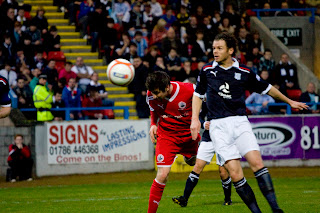Senior football in Stirling existed as far back as 1875,
with the formation of Kings Park FC.
Former members of the Stirlingshire Football Association -
they did not seek entry to the newly formed Scottish League - but instead
joined an alliance of teams in Central Scotland; Airdrieonians, Ayr, East
Stirlingshire, Morton F.C., Kilmarnock, King's Park, Linthouse F.C., Northern,
Partick Thistle, Port Glasgow Athletic, St Bernard's F.C. and Thistle.
A further opportunity presented itself in 1893 when a large
number of Alliance teams joined the newly formed second division of the
Scottish League but Kings Park preferred to join the Midland League, consisting
of nine clubs - Alloa Athletic, Alva, Bridge of Allan, Camelon, Clackmannan,
Dunblane, Dunfermline Athletic, Grangemouth and Raith Rovers.
They would win the League at first attempt but had no
further success in any competition.
Life outside of the senior Scottish Leagues was proving
difficult for clubs and eventually the league relented and expanded in 1921,
allowing a host of teams to apply. The top division of 22 teams remained and
the second division reformed to 20 teams.
The club remained a second division team throughout the
remainder of its existence, just missing out on promotion by one point in
season 1927/28.
When Britain declared war on Germany on 3 September 1939
because of a government ban on all outdoor activities, Scottish Football League
cancelled league football. In its place they set up regional leagues.
Kings Park featured in the Eastern Division in its first
season but in July 1940 as preparations were ongoing for the start of the new
season, a Luftwaffe Heinkel III dropped a single Hermann bomb on Forthbank, and
the stand was completely demolished and the playing surface severely damaged.
As a consequence Managing Director Tom Fergusson put the
club into limbo.
When the end of the war was declared, Managing Director Tom
Fergusson had two options: resurrect the former club, or start again. He chose
the latter and went about establishing a new club.
In May 1945, he was offered the grazing at Annfield; an
eighteenth-century mansion on the outskirts of Stirling. The house, with more
than 20 rooms and 70 acres of ground, was for sale at £5,000. As he walked up
the long drive skirting an area of woodland in front of the house, Fergusson
had a vision of the future, with the trees cleared away, the ground levelled,
and thousands of people cheering a football team.
Meetings were arranged with friends, business people and
supporters. It was agreed to purchase the land for £5,000 and set up a private
company with six shareholders each owning 500 shares.
The first meeting to promote the new Stirling Albion
Football Club took place at 54 Wallace Street, premises of T.H. Fergusson Coal
Merchants, on May 10th 1945. Five local businessmen contributed funds to launch
the new club, and after consideration of names such as Stirling Villa and
King's Park, Stirling Albion was chosen.
It was not all sweetness and light. There were many
objections to the construction of Annfield, particularly from locals, but also
business people who had debts owing to them by Kings Park.
Stirling Town Council Planning Committee turned down the
application by four votes to three. Tom Fergusson, undeterred, requested that a
deputation be heard by the full council and on 21st May, the Provost,
Magistrates and Councillors of the Royal Burgh of Stirling met to hear Mr. A.
J. Gourlay, Mr. P. McGlaughlin and Mr. T. H Fergusson. The Councillors voted to
allow the ground to be built, provided it was for sport only and excluded dog
racing and pony trotting.
Weeks later the dream had become a reality. Stirling Albion
Football Club Ltd was formed and Annfield house bought as club headquarters.
The ballroom became the gymnasium, with a miniature football field painted on
the floor ready for tactical talks; other rooms were converted into dressing
rooms, a laundry, and a tea room.
While volunteer workers were busy making a stand out of old
air raid shelters, others were uprooting oaks and other trees, laying the
pitch, and building up terracing.
The Club was run from Fergusson's coal premises in Wallace
Street for many years. As Secretary and Manager he was responsible for
day-to-day running of the club and for team affairs, along with PR and dealing
with his ‘auld enemies’ in the higher echelons of the Scottish Football
Association and League Committees.
Meantime a team had to be raised, and a competition found
for them to play in.
To be continued.

